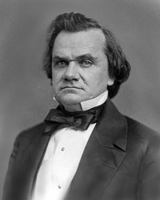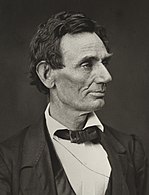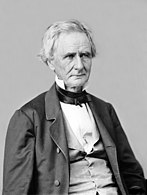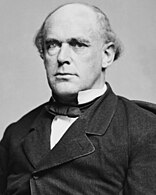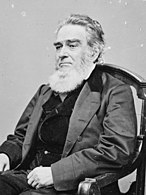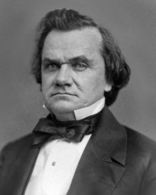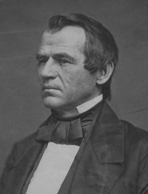
A | B | C | D | E | F | G | H | CH | I | J | K | L | M | N | O | P | Q | R | S | T | U | V | W | X | Y | Z | 0 | 1 | 2 | 3 | 4 | 5 | 6 | 7 | 8 | 9
| ||||||||||||||||||||||||||||||||||||||||||||||||||||||||||||||||
303 members of the Electoral College 152 electoral votes needed to win | ||||||||||||||||||||||||||||||||||||||||||||||||||||||||||||||||
|---|---|---|---|---|---|---|---|---|---|---|---|---|---|---|---|---|---|---|---|---|---|---|---|---|---|---|---|---|---|---|---|---|---|---|---|---|---|---|---|---|---|---|---|---|---|---|---|---|---|---|---|---|---|---|---|---|---|---|---|---|---|---|---|---|
| Turnout | 81.8%[1] | |||||||||||||||||||||||||||||||||||||||||||||||||||||||||||||||
| ||||||||||||||||||||||||||||||||||||||||||||||||||||||||||||||||
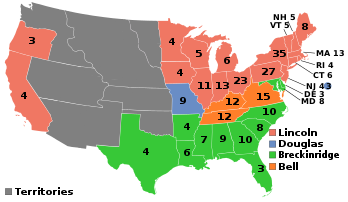 Presidential Election results map. Red denotes states won by Lincoln/Hamlin, green by Breckinridge/Lane, orange by Bell/Everett, and blue by Douglas/Johnson. Numbers indicate electoral votes cast by each state. | ||||||||||||||||||||||||||||||||||||||||||||||||||||||||||||||||
| ||||||||||||||||||||||||||||||||||||||||||||||||||||||||||||||||
The 1860 United States presidential election was the 19th quadrennial presidential election, held on Tuesday, November 6, 1860. In a four-way contest, the Republican Party ticket of Abraham Lincoln and Hannibal Hamlin[2] won a national popular plurality, a popular majority in the North where states already had abolished slavery, and a national electoral majority comprising only Northern electoral votes. Lincoln's election thus served as the main catalyst of the states that would become the Confederacy seceding from the Union. This marked the first time that a Republican was elected president. It was also the first presidential election in which both major party candidates were registered in the same home state; the others have been in 1904, 1920, 1940, 1944, and 2016.
The United States had become increasingly sectionally divided during the 1850s, primarily over extending slavery into the western territories. The incumbent president, James Buchanan, like his predecessor, Franklin Pierce, was a Northern Democrat with Southern sympathies. Buchanan also adamantly promised not to seek re-election. From the mid-1850s, the anti-slavery Republican Party became a major political force, driven by Northern voter opposition to the Kansas–Nebraska Act and the Supreme Court's 1857 decision in Dred Scott v. Sandford. From the election of 1856, the Republican Party had replaced the defunct Whig Party as the major opposition to the Democrats. A group of former Whigs and Know Nothings formed the Constitutional Union Party, which sought to avoid disunion by resolving divisions over slavery with some new compromise.
The 1860 Republican National Convention in Chicago nominated Abraham Lincoln, a moderate former one-term Whig Representative from Illinois. Its platform promised not to interfere with slavery in the South but opposed extension of slavery into the territories. The 1860 Democratic National Convention adjourned in Charleston, South Carolina, without agreeing on a nominee, but a second convention in Baltimore, Maryland, nominated Illinois Senator Stephen A. Douglas. Douglas's support for the concept of popular sovereignty, which called for each territory's settlers to decide locally on the status of slavery, alienated many radical pro-slavery Southern Democrats, who wanted the territories, and perhaps other lands, open to slavery. With President Buchanan's support, Southern Democrats held their own convention, nominating Vice President John C. Breckinridge of Kentucky. The 1860 Constitutional Union Convention, which hoped to avoid the slavery issue entirely, nominated a ticket led by former Tennessee Senator John Bell.
Lincoln's main opponent in the North was Douglas, who won the popular vote in Missouri, electoral votes in New Jersey, and the second highest popular vote total nationally. Douglas was the only candidate in the 1860 election to win electoral votes in both free and slave states. In the South, Bell won three states and Breckinridge swept the remaining 11. Lincoln's election motivated seven Southern states, all voting for Breckinridge, to secede before the inauguration in March. The American Civil War began less than two months after Lincoln's inauguration, with the Battle of Fort Sumter; afterwards four further states seceded. Lincoln would go on to win re-election in the 1864 United States presidential election. The election was the first of six consecutive Republican victories. Despite Lincoln's commanding victory, this was the first election in American history in which the winner has failed to win his home county, with Lincoln narrowly losing Sangamon County, Illinois to Douglas. However, he would win Gasconade County, Missouri, which as of the 2020 United States presidential election, has voted Republican ever since, marking the beginning of the longest active voting streak for any party at the county level.
Nominations
The 1860 presidential election conventions were unusually tumultuous, due in particular to a split in the Democratic Party that led to both Northern and Southern party conventions.
Republican nomination
| 1860 Republican Party ticket | |||||||||||||||||||||||||||||
|---|---|---|---|---|---|---|---|---|---|---|---|---|---|---|---|---|---|---|---|---|---|---|---|---|---|---|---|---|---|
| Abraham Lincoln | Hannibal Hamlin | ||||||||||||||||||||||||||||
| for President | for Vice President | ||||||||||||||||||||||||||||
 |
 | ||||||||||||||||||||||||||||
| U.S. Representative for Illinois's 7th (1847–1849) |
U.S. Senator from Maine (1848–1857, 1857–1861) | ||||||||||||||||||||||||||||
| Campaign | |||||||||||||||||||||||||||||
Republican candidates:
- Abraham Lincoln, former representative from Illinois
- William Seward, senator from New York
- Simon Cameron, senator from Pennsylvania
- Salmon P. Chase, governor of Ohio
- Edward Bates, former representative from Missouri
- John McLean, associate justice of the U.S. Supreme Court
- Benjamin Wade, senator from Ohio
- William L. Dayton, former senator from New Jersey
Republican Party candidates gallery

The Republican National Convention met in mid-May 1860 after the Democrats had been forced to adjourn their convention in Charleston. With the Democrats in disarray and a sweep of the Northern states possible, the Republicans felt confident going into their convention in Chicago. William H. Seward from New York was considered the front-runner, followed by Salmon P. Chase from Ohio, and Missouri's Edward Bates. Abraham Lincoln from Illinois, was lesser-known, and was not considered to have a good chance against Seward. Seward had been governor and senator of New York and was an able politician with a Whig background. Also running were John C. Frémont, William L. Dayton, Cassius M. Clay, and Benjamin Wade, who might be able to win if the convention deadlocked.[3]
As the convention developed, however, it was revealed that frontrunners Seward, Chase, and Bates had each alienated factions of the Republican Party. Seward had been painted as a radical, and his speeches on slavery predicted inevitable conflict, which spooked moderate delegates. He also was firmly opposed to nativism, which further weakened his position. He had also been abandoned by his longtime friend and political ally Horace Greeley, publisher of the influential New-York Tribune.[3]
Chase, a former Democrat, had alienated many of the former Whigs by his coalition with the Democrats in the late 1840s. He had also opposed tariffs demanded by Pennsylvania and even had opposition from his own delegation from Ohio.[citation needed] However, Chase's firm antislavery stance made him popular with the Radical Republicans. But what he offered in policy he lacked in charisma and political acumen.[3]
The conservative Bates was an unlikely candidate but found support from Horace Greeley, who sought any chance to defeat Seward, with whom he now had a bitter feud. Bates outlined his positions on the extension of slavery into the territories and equal constitutional rights for all citizens, positions that alienated his supporters in the border states and Southern conservatives, while German Americans in the party opposed Bates because of his past association with the Know Nothings.[3]
Into this mix came Lincoln. He was not unknown; he had gained prominence in the 1858 Lincoln–Douglas debates and had represented Illinois in the House of Representatives. Lincoln had been quietly eyeing a run since the debates, ensuring that they were widely published and that a biography of himself was published. He gained great notability with his acclaimed February 1860 Cooper Union speech, which may have ensured him the nomination although he had not yet announced his intention to run. Delivered in Seward's home state and attended by Greeley, Lincoln used the speech to show that the Republican Party was a party of moderates, not crazed fanatics, as Southerners and Democrats claimed. Afterward, Lincoln was in much demand for speaking engagements.[3][4] As the convention approached, Lincoln did not campaign actively, as the "office was expected to seek the man". So it did at the Illinois state convention, a week before the national convention. Young politician Richard Oglesby found several fence rails that Lincoln may have split as a youngster and paraded them into the convention with a banner that proclaimed Lincoln to be "The Rail Candidate" for president. Lincoln received a thunderous ovation, surpassing his and his political allies' expectations.[3] Lincoln's campaign managers had printed and distributed thousands of fake convention admission tickets to Lincoln supporters to ensure and increase the crowd's support.[5]
Even with such support from his home state, Lincoln faced a difficult task if he was to win the nomination. He set about ensuring that he was the second choice of most delegates, realizing that the first round of voting at the convention was unlikely to produce a clear winner. He engineered that the convention would happen in Chicago, which would be inherently friendly to the Illinois-based Lincoln. He also made sure that the Illinois delegation would vote as a bloc for him. Lincoln did not attend the convention in person and left the task of delegate wrangling to several close friends.[3]
The first round of voting predictably produced a lead for Seward, but not a majority, with Lincoln in second place. The second round eliminated most of the minor contenders, with voters switching mostly to Seward or Lincoln. The convention remained deadlocked, however, and skillful political maneuvering by Lincoln's delegate wranglers convinced some delegates to abandon Seward in favor of Lincoln. Lincoln's combination of a moderate stance on slavery, long support for economic issues, his western origins, and strong oratory proved to be exactly what the delegates wanted in a president. On the third ballot on May 18, Lincoln secured the presidential nomination overwhelmingly.[3][6] Senator Hannibal Hamlin from Maine was nominated for vice president, defeating Clay. Hamlin was surprised by his nomination, saying he was "astonished" and that he "neither expected nor desired it."[7]
The party platform[8] promised not to interfere with slavery in the states, but opposed slavery in the territories. The platform promised tariffs protecting industry and workers, a Homestead Act granting free farmland in the West to settlers, and the funding of a transcontinental railroad. There was no mention of Mormonism (which had been condemned in the Party's 1856 platform), the Fugitive Slave Act, personal liberty laws, or the Dred Scott decision.[9] While the Seward forces were disappointed at the nomination of a little-known western upstart, they rallied behind Lincoln, while abolitionists were angry at the selection of a moderate and had little faith in Lincoln.[10][11]
Democratic (Northern Democratic) Party nomination
This section needs additional citations for verification. (November 2023) |
| 1860 Democratic Party ticket | |||||||||||||||||||||||||||||
|---|---|---|---|---|---|---|---|---|---|---|---|---|---|---|---|---|---|---|---|---|---|---|---|---|---|---|---|---|---|
| Stephen A. Douglas | Herschel V. Johnson | ||||||||||||||||||||||||||||
| for President | for Vice President | ||||||||||||||||||||||||||||
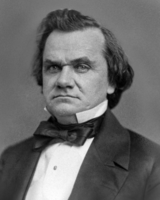 |
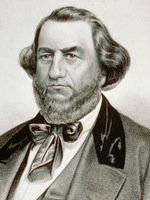 | ||||||||||||||||||||||||||||
| U.S. Senator from Illinois (1847–1861) |
41st Governor of Georgia (1853–1857) | ||||||||||||||||||||||||||||
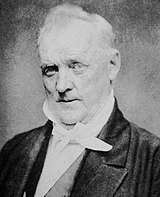
Northern Democratic candidates:
- Stephen Douglas, senator from Illinois
- James Guthrie, former treasury secretary from Kentucky
- Robert Mercer Taliaferro Hunter, senator from Virginia
- Joseph Lane, senator from Oregon
- Daniel S. Dickinson, former senator from New York
- Andrew Johnson, senator from Tennessee
- Howell Cobb, treasury secretary from Georgia
Democratic Party candidates gallery

At the Democratic National Convention held in Institute Hall in Charleston, South Carolina, in April 1860, 50 Southern Democrats walked out over a platform dispute, led by the extreme pro-slavery "Fire-Eater" William Lowndes Yancey and the Alabama delegation: following them were the entire delegations of Florida, Georgia, Louisiana, Mississippi, South Carolina and Texas, three of the four delegates from Arkansas, and one of the three delegates from Delaware.

Six candidates were running: Stephen A. Douglas from Illinois, James Guthrie from Kentucky, Robert Mercer Taliaferro Hunter from Virginia, Joseph Lane from Oregon, Daniel S. Dickinson from New York, and Andrew Johnson from Tennessee, while three other candidates, Isaac Toucey from Connecticut, James Pearce from Maryland, and Jefferson Davis from Mississippi (the future president of the Confederate States) also received votes.
Douglas, a moderate on the slavery issue who favored "popular sovereignty", was ahead on the first ballot, but was 56½ votes short of securing the nomination. On the 57th ballot, with Douglas still ahead, but 51½ votes short of the nomination, the exhausted and desperate delegates agreed on May 3 to cease voting and adjourn the convention.
While the Democrats convened again at the Front Street Theater in Baltimore, Maryland, on June 18, 110 Southern delegates (led by "Fire-Eaters") boycotted the convention or walked out after the convention informed them they would not adopt a resolution supporting extending slavery into territories whose voters did not want it.
While some considered Horatio Seymour a compromise candidate for the national Democratic nomination at the reconvening convention in Baltimore, Seymour wrote a letter to the editor of his local newspaper declaring unreservedly that he was not a candidate for either spot on the ticket. After two ballots - the 59th ballot overall - the remaining Democrats nominated Stephen A. Douglas from Illinois for president.[13] The election would now pit Lincoln against his longtime political rival, whom Lincoln had lost to in the Illinois senate race just two years earlier. That two candidates were from Illinois showed the importance of the West in the election.[3]
While Benjamin Fitzpatrick from Alabama was nominated for vice president, he refused the nomination.
After the convention concluded with no vice presidential nominee, Douglas offered the vice presidential nomination to Herschel V. Johnson from Georgia, who accepted.
Southern Democratic Party nomination
| John C. Breckinridge | Joseph Lane |
|---|---|
| for President | for Vice President |
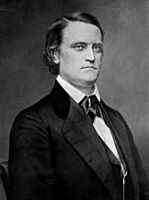 |
 |
| 14th Vice President of the United States (1857–1861) |
U.S. Senator from Oregon (1859–1861) |
Southern Democratic candidates:
- John C. Breckinridge, Vice President of the United States
- Daniel S. Dickinson, former senator from New York
- Robert Mercer Taliaferro Hunter, senator from Virginia
- Joseph Lane, senator from Oregon
- Jefferson Davis, senator from Mississippi
Southern Democratic Party candidates gallery
-
Zdroj:https://en.wikipedia.org?pojem=1860_United_States_presidential_election
Text je dostupný za podmienok Creative Commons Attribution/Share-Alike License 3.0 Unported; prípadne za ďalších podmienok. Podrobnejšie informácie nájdete na stránke Podmienky použitia.
Antropológia
Aplikované vedy
Bibliometria
Dejiny vedy
Encyklopédie
Filozofia vedy
Forenzné vedy
Humanitné vedy
Knižničná veda
Kryogenika
Kryptológia
Kulturológia
Literárna veda
Medzidisciplinárne oblasti
Metódy kvantitatívnej analýzy
Metavedy
Metodika
Text je dostupný za podmienok Creative
Commons Attribution/Share-Alike License 3.0 Unported; prípadne za ďalších
podmienok.
Podrobnejšie informácie nájdete na stránke Podmienky
použitia.
www.astronomia.sk | www.biologia.sk | www.botanika.sk | www.dejiny.sk | www.economy.sk | www.elektrotechnika.sk | www.estetika.sk | www.farmakologia.sk | www.filozofia.sk | Fyzika | www.futurologia.sk | www.genetika.sk | www.chemia.sk | www.lingvistika.sk | www.politologia.sk | www.psychologia.sk | www.sexuologia.sk | www.sociologia.sk | www.veda.sk I www.zoologia.sk



